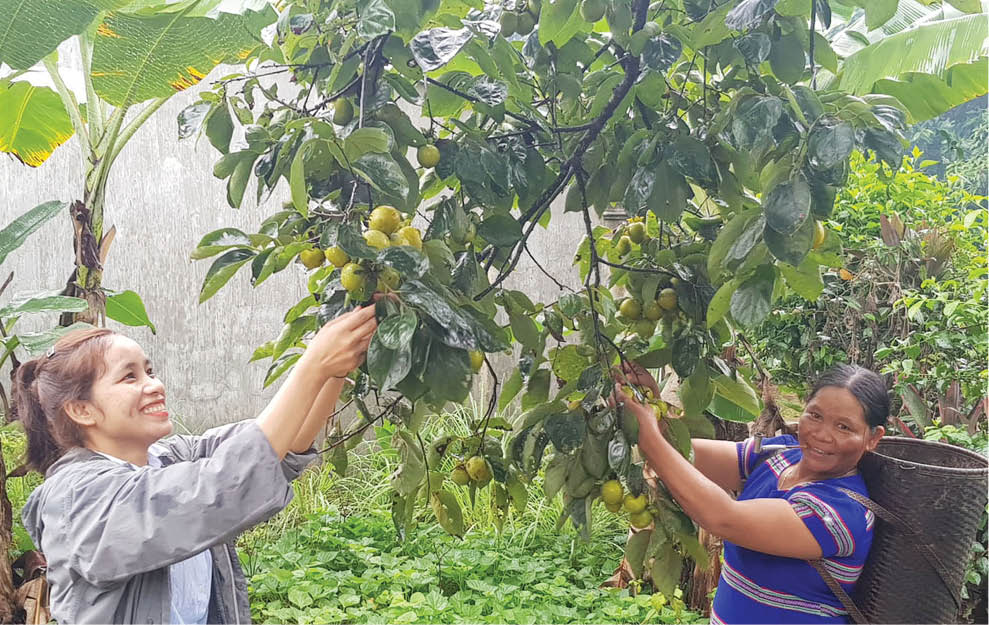
Harvesting crispy persimmons at people's houses in Hong Bac commune
In the ripe persimmon season, Mrs. Kan Tei in A Ngo commune sat with her niece throughout the noon selling a few baskets of persimmon. Mrs. Tei said that her granddaughter was clumsy in calculations, so she went out to help. Her persimmon trees have been harvested for the second time, each selling is about 200,000 VND.
Along the Ho Chi Minh Road this season, we often see people bringing persimmons to sell in front of their yards. The 5 persimmon trees of Mr. Ho Van Xe in Hong Kim commune are the favorite dishes of the children in the house, sometimes sold, so they also earn more money. He said, ‘compared to the plants in the garden, persimmons and bananas bring more valuable resources’.
The whole district of A Luoi still has a few hectares of persimmons, much less than the number of tens of hectares before. Around the year 2000, there was a movement to grow persimmons on a large scale;but due to the lack of careful research, after a few years, it was discovered that the persimmon variety brought back was acrid persimmon which had low value, so people cut it down.
Recently, in the direction of selective persimmon development, persimmons have been well received by the market, and persimmon gardens have begun to recover.
Hong Bac commune is the largest persimmon growing area in A Luoi district. From September to October, the persimmon harvest season makes the roads in the commune very busy. The houses are colored in orange and red colors of ripe persimmons, attracting many young people to "check-in".
With 350 households growing persimmons, each garden has from a few trees to a few dozen trees, so when you step into the gates of the villages, you will see the persimmon branches laden with branches reaching out to the street.
Ms. Tran Thi Oanh from Hong Bac commune invited us to eat orange persimmons with the size of a rice bowl. Persimmons had a fragrant, crispy, sweet taste. Just one persimmon could make us quite full.
She said that she had planted 5 hybrid persimmons that were 4 years old. At 3 years old, the trees started to harvest 200 to 300kg of fruit in the first crop. This year, the trees give more persimmons. The price of persimmons is from 20,000 to 30,000 VND per kg.
“First time selling agricultural products from the garden to earn millions. I'm very happy, so next year I will plant more," said Oanh.
Visiting Mr. Ho Van Ke, 80 years old, one of the first people involved in the development of persimmon trees in A Luoi, I heard about the ups and downs of persimmon trees in this land. Mr. Ke pondered a lot when the persimmon was cut off because it cost only a few thousand dongs.
After surveying, he discovered a few quality persimmon varieties in the home gardens of the locals, so he found a way to graft and share with people how to replant the persimmon garden.
Mr. Ho Van Chau, an officer in charge of agriculture in Hong Bac commune, said that currently, people mainly grow Phu Du persimmons, egg-shaped persimmons, and orange persimmons. A single orange persimmon tree can bring in an income of 1 to 2 million dongs from selling persimmons. Implementing the policy of the district, the commune registered to graft 500 persimmon trees, now more than 300 trees have been grafted.
"In the coming time, we will continue to encourage people to complete the conversion of low-value persimmons to Phu Du persimmons and orange persimmons," Mr. Chau informed.
On average, each hectare of persimmon yields 260-300 quintals of fruit. This year, the price of persimmon ranges from 10,000 - 30,000 VND per kg depending on the type. Persimmon growing area is concentrated in Hong Bac, Hong Kim, A Ngo communes, A Luoi town, etc. The main varieties of persimmons grown are orange persimmon, pointed persimmon, square persimmon, Phu Du persimmon, etc., in which, cup persimmon is the most valuable.
According to Ms. Ho Thi Hai Dang, an expert at A Luoi Agricultural Service Center, the center organizes the grafting and improvement of acrid persimmon trees to popular persimmon varieties with about 200 trees and is continuing to be deployed in many areas.
Story and photo: Linh Tue